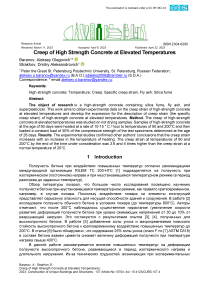Ползучесть высокопрочного бетона при повышенных температурах
Автор: Баранов А.О., Страхов Д.А.
Журнал: Строительство уникальных зданий и сооружений @unistroy
Статья в выпуске: 2 (107), 2023 года.
Бесплатный доступ
Объект исследования – высокопрочный бетон, содержащий микрокремнезем, золу-унос и суперпластификатор. Целью данной работы является получение экспериментальных данных по деформации ползучести высокопрочного бетона при повышенных температурах и разработка выражения для описания деформации ползучести (удельной деформации ползучести) высокопрочного бетона при повышенных температурах. Метод. Ползучесть высокопрочного бетона при повышенных температурах изучали на невысыхающих образцах. Образцы высокопрочного бетона в возрасте 90 суток нагревали со скоростью 10-15°С/час до температур 90 и 200°С, а затем нагружали постоянной нагрузкой, равной 30 % прочности на сжатие испытуемых образцов. определяется в возрасте 28 дней. Полученные результаты. Экспериментальные исследования подтвердили выводы других авторов о том, что деформация ползучести увеличивается с увеличением температуры нагрева. Деформация ползучести при температурах 90 и 200°С к концу рассматриваемого времени была в 3,6 и 4 раза выше деформации ползучести при нормальной температуре 20°С.
Высокопрочный бетон, температура, ползучесть, удельная деформация ползучести, зольная пыль, микрокремнезем
Короткий адрес: https://sciup.org/143180500
IDR: 143180500 | УДК: 69 | DOI: 10.4123/CUBS.107.4
Текст научной статьи Ползучесть высокопрочного бетона при повышенных температурах
Ползучесть бетона при воздействии повышенных температур согласно рекомендациям международной организации RILEM TC 200-HTC [1] подразделяется на ползучесть при изотермическом (постоянном) нагреве и при неустановившемся температурном режиме (в период разогрева до заданных температур).
Обзор литературы показал, что большое число исследований посвящено изучению ползучести бетона при неустановившемся температурном режиме, как правило кратковременном, например, в случае пожара. Поскольку воздействие пожара на элементы конструкций представляет серьезную опасность для несущей способности зданий и сооружений. В работе [2] исследовали ползучесть обычного бетона в условиях пожара (до температуры 800°C). Авторы отмечают, что после 300°C наблюдалось существенное нарастание (увеличение скорости развития) деформаций ползучести бетона при уровне сжимающих напряжений от 30 до 70% от разрушающей нагрузки. Это согласуются с результатами опытов [3], [4], полученных для высокопрочного бетона. В работе [5] добавление золы уноса и микрокремнезема повысило стойкость высокопрочного бетона к кратковременному воздействию повышенных температур до 200°C. В статье [6] было обнаружено, что содержание 25% золы уноса (класс F по [7] ASTM C618) в составе бетона взамен цемента снижает величину деформаций ползучести при температуре нагрева свыше 400°C.
В данной работе рассматривается влияние повышенных температур на деформации ползучести высокопрочного бетона, развивающиеся в период изотермического нагрева и длительного нагружения. Из-за технических трудностей, возникающих при экспериментальных исследованиях ползучести бетона при изотермическом нагреве при повышенных температурах, количество работ ограничено.
В работе [9] проводились исследования влияния изотермического нагрева на деформации ползучести старого высыхающего бетона. Результаты опытов показали, что предельные значения удельных деформаций ползучести (мера ползучести) бетона при температурах нагрева 120-200°C превышали значения при нормальной температуре в 3.2–3.76 раза.
В статье [10] авторы опубликовали результаты исследования воздействия повышенных температур 90, 150 и 200°С на ползучесть высокопрочного бетона. Образцы в возрасте около 40 суток разогревались до заданных значений температуры со скоростью 12–15 °С / час и после загружались длительной сжимающей нагрузкой, соответствующей 50% от призменной прочности бетона. Удельные деформации ползучести за 3 месяца выдержки под нагрузкой при температурах нагрева 90, 150 и 200°С были больше соответственно в 2.3, 2.6 и 2.7 раза, чем для образцов, находившихся при температуре 20°С.
В исследованиях авторов [11], [12] изучалась базовая (при изотермическом нагреве) ползучесть гидроизолированного высокопрочного бетона в возрасте более 300 суток на портландцементе с активностью 52.5 МПа (CEM I) и 42.5 МПа (CEM V/A). Нагрузка прикладывалась после нагрева образцов до заданных температур. Деформации ползучести для обоих составов бетона при температуре нагрева 50°C были выше примерно в 2 раза, чем при 20°C. При 80°C деформации ползучести превышали в 4.4 раз (CEM V/A) и 9.2 (CEM I) уже после 20 дней приложения нагрузки на образцы.
В работе [13] величина деформации базовой ползучести цементного раствора, измеренная на изолированных от высыхания образцах через 600 суток, увеличилась в 1.5 и 2.4 раза соответственно при 60°C и 80°C по сравнению с деформацией ползучести при температуре 20°C.
Из работ следующих авторов [8]–[12], [14]–[17] установлено, что для бетона в позднем возрасте с повышением температуры нагрева существенно возрастает скорость нарастания деформаций ползучести в первое время после приложения нагрузки и затем имеет место более быстрое их затухание в последующий период. При этом нагрев бетона увеличивает и величину предельной деформации ползучести в сравнении с значениями, полученных при нормальной (комнатной) температуре.
В работе [18] исследует влияние масштабного фактора (размеров бетонных образцов и модуля открытой поверхности) при изотермическом нагреве до 200°C на деформации ползучести Baranov, A.; Strakhov D.
Creep of High Strength Concrete at Elevated Temperatures;
высокопрочного бетона при осевом сжатии. Опыты автора показали, что с увеличением модуля открытой поверхности (отношение поверхности элемента, открытой для высыхания, к объему) увеличиваются деформации ползучести.
Анализ работ авторов не выявил однозначной зависимости между величиной деформации ползучести бетона и температурой при изотермическом (постоянном) нагреве. Совершено, очевидно, что на результаты испытаний, помимо температуры, оказывают свое влияние многие другие факторы (например, состав бетона, условия хранения образцов до испытания, величина напряжений, методика испытания и т. п.). Таким образом, можно сказать, что влияние повышенных температур на ползучесть бетона в период длительного нагружения изучено недостаточно.
Целью данной работы является получение опытных данных о деформациях ползучести высокопрочного бетона в условиях воздействия повышенной температуры и длительного нагружения сжимающей нагрузкой и разработка достаточно универсального аналитического выражения по описанию мер ползучести бетона при воздействии повышенных температур.
-
2 Materials and Methods
Следующие компоненты использовались для изготовления высокопрочного бетона:
-
- портландцемент ЦЕМ I 42.5Н соответствует межгосударственному стандарту ГОСТ 311082020 [19], АО «Евроцемент груп», завод «Петербургцемент, Санкт-Петербург, Россия;
-
- природный песок с содержанием SiO 2 не менее 81.4% и модулем крупности 2.3,
соответствует межгосударственному стандарту ГОСТ 8736-2014 [20], компания «РЕМИКС», Санкт-Петербург, Россия;
-
- гранитный щебень (фракций от 5-10 и 10-20 мм) соответствует межгосударственному стандарту ГОСТ 8267-93 [21], АО «Семиозерское карьероуправление», месторождение «Петровское», Ленинградская область, Россия;
-
- водопроводная вода соответствует межгосударственному стандарту ГОСТ 23732-2011 [22];
-
- многокомпонентный модификатор для бетона МБ10-30С соответствует национальному стандарту Российской Федерации ГОСТ Р 56178-2014 [23], ООО «Предприятие Мастер Бетон», Москва, Россия.
Модификатор введен в состав бетона в размере 20% от массы цемента. Модификатор содержит следующие компоненты в процентах от общей массы добавки: микрокремнезем конденсированный (63%), золу уноса сухого отбора тепловых станций (27%) и суперпластификатор С3 (10%).
В таблице 1 представлены данные о составе и механических характеристиках бетона.
Таблица 1. Расход материалов на 1 м3 бетонной смеси и механические характеристики бетона в возрасте 28 суток
Table 1. Mixture proportions fresh concrete and characteristics of concrete at the age of 28 days
Компоненты бетонной смеси, кг/м3
В/Ц R, МПа R b , МПа Е, ГПа
Цемент Песок Щебень Вода МБ10-30С
490 790 850 170 100 0.35 90 68.2 36
Приготовление бетонной смеси осуществлялось в бетоносмесителе принудительного действия C162 (производитель «MATEST», Италия). Бетонную смесь укладывали в металлические формы в горизонтальном положении с последующим вибрированием на лабораторной виброплощадке C279 (производитель «MATEST», Италия). Образцы бетона через одни сутки освобождались от форм и после выдерживались в течение 27 дней в камере нормального хранения при температуре воздуха 20 ± 2ºС и относительной влажности воздуха 95±5% согласно межгосударственному стандарту ГОСТ 10180–2012 [24]. До момента испытания образцы после нормального хранения находились в условиях лаборатории при температуре 20 ± 2ºС и влажности воздуха 60 ±5%.
Результаты исследований влияния повышенных и высоких температур до 400°C на характеристики механических свойств (прочность на сжатие и растяжение, модуль упругости, коэффициент Пуассона) высокопрочного бетона с модификатором марки МБ опубликованы в следующих работах [25]–[27].
Исследование влияния повышенных температур на ползучесть высокопрочного бетона производилось на свободно высыхающих (неизолированных) образцах размерами 100х100х400 мм. Возраст бетона к моменту начала испытания был равен 90 суток. Подготовленные образцы устанавливали в пружинные установки и загружали длительной нагрузкой через 1 час после подъема температуры бетона до заданного значения (см. рисунок 1). Величина напряжений сжатия составляла около 30% (~ 21 тонна) от призменной прочности бетона в возрасте 28 суток. Нагрузка на испытательные образцы передавалось условно мгновенно в течение 0.5–1 мин. Кроме нагруженных образцов, в этом помещении находились неизолированные от высыхания призмы, предназначенные для измерения усадочных деформаций в условиях нагрева для последующего их исключения из общих деформаций под нагрузкой. Образцы были оборудованы индикаторами часового типа для измерения продольных деформаций на базе 250 мм.
Образцы нагревались со скоростью 10-15 ° С в час до температур 90 и 200 ° С, которые поддерживались постоянными в течение всего времени испытания. Заданная температура нагрева обеспечивалась соответствующей величиной электрического напряжения в электрической цепи спирали нагревательного устройства с помощью регулятора напряжений.
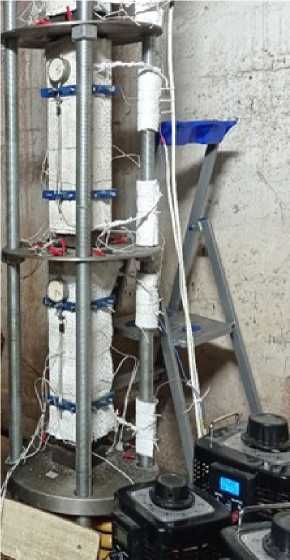
a)
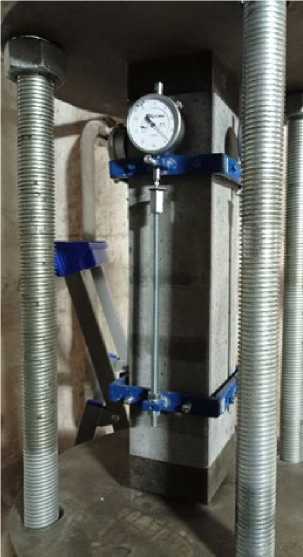
b)
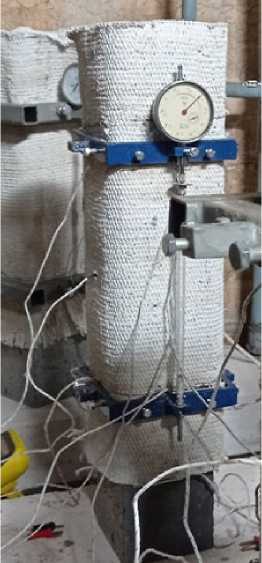
c)
Рис. 1. Общий вид образцов: под нагрузкой в пружинных установках для длительного испытания в условиях нагрева (а) и в нормальных условиях (b); поставленных на усадку в условиях нагрева (c)
Fig. 1. General view: creep samples at elevated temperatures (a) creep samples at 20 ° С (b);
shrinkage samples at elevated temperatures (c)
Измерение температуры бетона производилось с помощью хромель-копелевых термопар установленных в трех точках на поверхности образца и в двух точках, расположенных на центральной оси образца. Точность измерений температуры составляла ±3°C. Средняя температура образца T рассчитывается по формуле
T = T s
T - T )
где T c – это среднее значение двух показаний температуры, измеренное на центральной оси образца;
T s – это средняя температура поверхности образца, рассчитанная как средневзвешенное значение трех показаний температуры по формуле
T = s
( T + 2 T 2 + T 3 )
3 Results and Discussion
Экспериментальные кривые деформаций ползучести высокопрочного бетона, загруженного в возрасте 90 суток, при температуре 20 ° С (без нагрева) и изотермическом (постоянном) нагреве при температурах 90 и 200 ° С представлены на рисунке 2.
Проведенные экспериментальные исследования подтверждают выводы других авторов, что скорость нарастания деформаций ползучести увеличивается с повышением температуры нагрева. У образцов высокопрочного бетона после 10 суток выдержки под нагрузкой деформации ползучести при 90 и 200 ° С были соответственно в 7 и 9 раз больше, чем у образцов при температуре 20 ° С. В результате деформации ползучести к концу рассматриваемого периода времени при температуре 90 ° С оказались больше в 3.6 раза, а при 200 ° С в 4 раза.
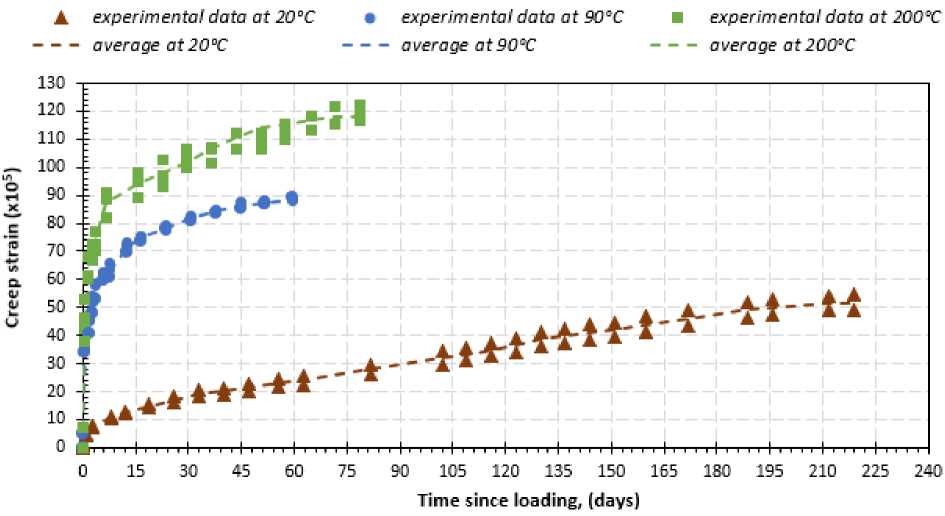
Рис. 2. Экспериментальные кривые деформаций ползучести при температурах 20, 90 и 200°С
Fig. 2. Creep strain curves at temperatures of 20, 90 and 200 °C
Для аналитического описания удельной деформации ползучести (меры ползучести) бетона в условиях изотермического нагрева при повышенных температурах предложены различные выражения.
В работе [28] авторы за основу принимают выражение (1), предложенное Aleksandrovsky S.V в [29], при нормальной температуре
γ ⋅ τ
C ( т , T ) = ^ ( т ) - ^ ( T ) —--- 2 - А( т ) • e а T -т ).
e Y T - A 2
Для зрелого бетона функции ф ( т) и Д ( т ) практически становятся константами и будут зависеть только от температуры нагрева t . Действие повышенных температур учитывается с помощью идеи приведенного времени ( T пр ). Идея заключается в том, что время отсчитывается не в обычной, а в приведенной, условной шкале, являющейся функцией температуры. Тогда, приняв за точку отсчета момент нагружения, выражение (1) переписывается в виде
1 А -аТ
C (т, T t ) = ф ( т ) -V( t )—^ Д( t ) • e "р , (2)
e Yln - A 2 V '
где
^ ( t ) = ф ( t ) -Д ( t ) ;
T np = K ( t) • T .
Tt – это длительность воздействия постоянной температуры на предварительно-нагруженный бетон;
ф t ) - это функция предельной меры ползучести бетона в зависимости от температуры;
Д ( t ) - это функция быстронатекающих деформаций ползучести от температуры;
Tпр – это приведенное время нагрева;
K ( t) - это коэффициент, учитывающий изменение масштаба времени в зависимости от температуры нагрева;
-
A 2 , у,а - это коэффициенты, подбираемые при аппроксимации экспериментальных данных.
По мнению авторов [28] выражение (2) удовлетворительно описывает экспериментальные данные, полученные для тяжелого бетона при изотермическом нагреве до температуры 200°С. Однако стоит отметить, что данное выражение несколько завышает значения мер ползучести в начальный период нагружения и занижает в последующий.
В статье [8] также принимается за основу выражение (1), однако не совсем понятно из текста работы как учитывается влияние повышенных температур на ползучесть бетона. Более того, полученное выражение не отвечает требованиям универсальности, т. к. для каждой температуры нагрева авторы подбирают разные коэффициенты.
Aleksandrovsky S.V. и Szusz F. в работе [30], принимая для описания своих экспериментов принцип аффинного подобия мер ползучести при разных температурах, предлагают зависимость вида
C(T , t - т ) = ф (Т) • C ( t - т ) , (3)
где Т – это температура нагрева;
C ( t - т ) - это мера ползучести при комнатной температуре (в опытах 26°С);
ф (Т ) - это функция температуры, в следующей форме
ф(Т) = 1 + g - g • e-в(T-To), здесь T0 = 26°С;
-
g , в - это параметры, подбираемые по опытным данным.
Авторы [30] утверждают, что получили хорошее согласование экспериментальных и расчетных результатов. Однако, это справедливо в основном при длительности действия нагрузки (t -т) более одного месяца, а в начальный период после нагружения наблюдается существенное расхождение опытных и расчетных кривых.
В большинстве случаев для удовлетворительного соответствия расчетных кривых удельных деформаций ползучести (при разных, но постоянных температурах) опытным данным необходимо использование функции, учитывающей одновременно влияние температуры и длительности действия нагрузки. Так, например, для аппроксимации опытных данных, приведенных на рисунке 3, целесообразно дополнить выражение 3, предложенную [30] следующей f (t - т) = 0.784 ■ e“Y1(t-т) + e-y2(t-т). (4)
Таким образом, при любой постоянной температуре удельные деформации ползучести выражаются
C ( T , t - т ) = ^ ( T ) ■ C ( t - т ) ■ f ( t - т ) , (5)
где g = 8.0; p = 0.02; T0 = 20°C; yx = 0.01; y2 = 0.3.
Выполненные в рамках описываемого исследования опыты при нормальной температуре (20 °С ) достаточно хорошо описываются следующей зависимостью удельных деформаций ползучести от длительности действия нагрузки
C ( t - т ) =
0.473 ( 1 - e -0.2( t -т )) + 2.127 ( 1 - e -0.01( t -т )) ■Ю -5 .
Выражение (5) вполне удовлетворительно описывает удельные деформации ползучести при разных повышенных температурах при длительности действия нагрузки до двух месяцев, однако приводит к значительным погрешностям при большей длительности. Последнее объясняется тем, что выражение (5) имеет экстремум (первая производная от C ( T , t - т ) по t равна нулю при t = 50 суток), что приводит к отрицательной скорости удельных деформаций ползучести при t - т > 50 суток.
Чтобы избавиться от этой погрешности целесообразно трансформировать выражения (4) следующим образом:
При t - т < 50 суток f (t - т) = 0.784 ■ e-0.01( t-т) + e ~03( t-т).
При t - т > 50 суток f (t - т) = 0.784 ■ e -0.01( t-т) + e -0.3( t-т) + 0.25 Г1 - e-0.008(( t-т)-50)
На рисунке 3 представлены кривые удельных деформаций ползучести (мер ползучести), рассчитанные по выражению (5) с учетом (7) и (8), и опытные данные.
A experimental data at 20°C • experimental data at 90°C ■ experimental data at 200T
— -equation (5) at20X — — - equation (5)at 90°C — — equation (5) at20041
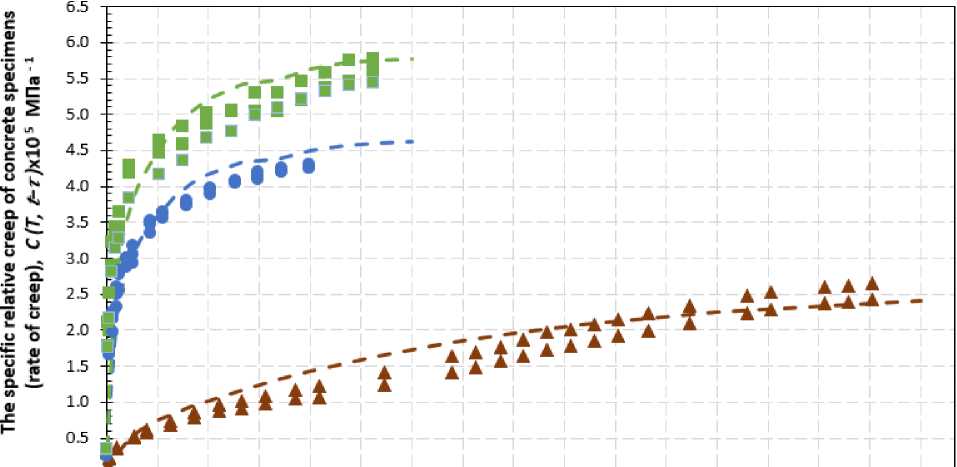
0.0 _j i । I I I I I I I । । । । । । । । I I । । । । । I I I I I I I I I । । । । । । I I I I I I I I I । । । । । I I I । । । । । । । I I I I I I I I । । । । । । । । I I
0 15 30 45 60 75 90 105 120 135 150 165 180 195 210 225 240
Time since loading, (days)
Рис. 3. Экспериментальные кривые удельных деформаций ползучести С (Т, t - т ) при температурах 20, 90 и 200°С
Fig. 3. Experimental curves of the specific creep strain of concrete specimens (rate of creep), С (Т , t - т ) at temperatures of 20, 90 and 200°C
4 Conclusions
-
1. Деформации ползучести высокопрочного бетона зависят от температуры нагрева и увеличиваются с повышением температуры. При температурах 90 и 200°С деформации ползучести к концу рассматриваемого периода времени превышали соответственно в 3.6 и 4 раза деформации ползучести, полученные при нормальной температуре 20°С.
-
2. Проведенные эксперименты подтверждают выводы других авторов о нелинейной зависимости удельных деформаций ползучести от температуры нагрева (до 200°С).
-
3. Кривые удельных деформаций ползучести (мер ползучести) при нормальной и повышенных температурах не являются аффинноподобными. Для получения значений этих деформаций при различных повышенных температурах следует умножать значения при нормальной температуре на множитель, зависящий не только от температуры, но и от продолжительности действия нагрузки. С увеличением длительности нагружения величина этого множителя снижается.
-
4. Предложенные зависимости (4)-(8) удовлетворительно аппроксимирует полученные опытные результаты и при надлежащем подборе коэффициентов имеют достаточно универсальный характер.
Список литературы Ползучесть высокопрочного бетона при повышенных температурах
- Schneider, U., Felicetti, R., Debicki, G., Diederichs, U., Franssen, J.M., Jumppanen, U.M., Khoury, G.A., Leonovich, S., Millard, A., Morris, W.A., Phan, L.T., Pimienta, P., Rodrigues, J.P.C., Schlangen, E., Schwesinger, P. and Zaytsev, Y. (2007) Recommendation of RILEM TC 200-HTC: Mechanical Concrete Properties at High Temperatures-Modelling and Applications : PGeneral Presentation. Materials and Structures/Materiaux et Constructions, 40, 841–853. https://doi.org/10.1617/s11527-007-9285-2.
- Alogla, S.M. and Kodur, V. (2020) Temperature-Induced Transient Creep Strain in Fiber-Reinforced Concrete. Cement and Concrete Composites, Elsevier Ltd, 113, 103719. https://doi.org/10.1016/j.cemconcomp.2020.103719.
- Buttignol, T.E.T. and Bitencourt, L.A.G. (2021) A Transient Creep Investigation Applied to the Mesoscopic Analysis of Plain Concrete under Uniaxial Compression at High Temperature. Fire Safety Journal, Elsevier Ltd, 126, 103484. https://doi.org/10.1016/j.firesaf.2021.103484.
- Yoon, M., Kim, G., Kim, Y., Lee, T., Choe, G., Hwang, E. and Nam, J. (2017) Creep Behavior of High-Strength Concrete Subjected to Elevated Temperatures. Materials, 10, 781. https://doi.org/10.3390/ma10070781.
- Korsun, V., Vatin, N., Korsun, A. and Nemova, D. (2014) Physical-Mechanical Properties of the Modified Fine-Grained Concrete Subjected to Thermal Effects up to 200°С. Applied Mechanics and Materials, Trans Tech Publications Ltd, 1013–1017. https://doi.org/10.4028/www.scientific.net/AMM.633-634.1013.
- Fan, K., Li, J., He, Z., Liu, Q. and Yao, Y. (2022) Transient Creep Strain of Fly Ash Concrete at Elevated Temperatures. https://doi.org/10.1680/jmacr.21.00267, Thomas Telford Ltd , 74, 1176–1187. https://doi.org/10.1680/JMACR.21.00267.
- ASTM C618-22 Standard Specification for Coal Fly Ash and Raw or Calcined Natural Pozzolan for Use. American Society for Testing and Materials, West Conshohocken, PA, USA: ASTM International, 5. https://doi.org/10.1520/C0618-22.
- Milovanov, A.F. and Tupov, N.I. (1969) Polzuchest’ i Relaksaciya Napryazhenij v Betone Zrelogo Vozrasta Pri Dlitel’nom Dejstvii Povyshennyh Temperatur [Creep and Stress Relaxation in Mature Concrete under Prolonged Exposure to Elevated Temperatures]. Polzuchest' i Usadka Betona [Creep and Shrinkage of Concrete], 79-91. https://search.rsl.ru/ru/record/01007328607 (date of application: 26.01.2023).
- Krichevsky, A.P. (1984) Raschet Zhelezobetonnyh Inzhenernyh Sooruzhenij Na Temperaturnye Vozdejstviya [Calculation of Reinforced Concrete Engineering Structures for Temperature Effects]. Stroyizdat., Moscow. https://search.rsl.ru/ru/record/01001213791 (date of application: 26.01.2023).
- Korsun, V., Korsun, A. and Volkov, A. (2013) Characteristics of Mechanical and Rheological Properties of Concrete under Heating Conditions up to 200°C. MATEC Web of Conferences, EDP Sciences, 6. https://doi.org/10.1051/MATECCONF/20130607002.
- Vidal, T., Sellier, A., Ladaoui, W. and Bourbon, X. (2013) Effect of Temperature on Basic Creep of High Performance Concretes Heated between 20°C and 80°C. Sustainable Construction Materials and Technologies, 2013-Augus. https://doi.org/10.1061/(asce)mt.1943-5533.0001063.
- Ladaoui, W., Vidal, T., Sellier, A. and Bourbon, X. (2013) Analysis of Interactions between Damage and Basic Creep of HPC and HPFRC Heated between 20 and 80 °c. Materials and Structures/Materiaux et Constructions, 46, 13–23. https://doi.org/10.1617/s11527-012-9879-1.
- Baranikumar, A., Torrence, C.E. and Grasley, Z. (2022) Thermorheological Approach to Predict Long-Term Creep of Cement Mortar from Short-Term Tests. Mechanics of Time-Dependent Materials, Springer Science and Business Media B.V., 26, 289–307. https://doi.org/10.1007/S11043-021-09488-Y/FIGURES/14.
- Vasiliev, P.I. and Gavrilin, B.A. (1969) Vliyanie Temperatury Na Polzuchest' Stareyushchego Betona [The Effect of Temperature on the Creep of Aging Concrete]. Polzuchest' i Usadka Betona [Creep and Shrinkage of Concrete], 9–20. https://search.rsl.ru/ru/record/01007328607 (date of application: 26.01.2023).
- Vorobeva, A., Strakhov, D. and Semenov, K. (2021) Calculation of Reinforced Concrete Elements Taking into Account Nonlinear Creep at Different Loading Mode. Lecture Notes in Civil Engineering, Springer Science and Business Media Deutschland GmbH, 150 LNCE, 73–84. https://doi.org/10.1007/978-3-030-72404-7_8/TABLES/5.
- Torrenti, J.M. (2017) Basic Creep of Concrete-Coupling between High Stresses and Elevated Temperatures. European Journal of Environmental and Civil Engineering, Taylor & Francis, 22, 1419–1428. https://doi.org/10.1080/19648189.2017.1280417.
- Guerrieri, M. and Fragomeni, S. (2015) Creep and Mechanical Properties of Concrete after Exposure to Elevated Temperatures. CONCREEP 10, American Society of Civil Engineers, Reston, VA, 1177–1186. https://doi.org/10.1061/9780784479346.140.
- Volkov, A.S. (2021) The Influence of the Scale Factor and the Effect of Elevated Temperatures up to +200 °C on the Characteristics of the Physico-Mechanical and Rheological Properties of High-Strength Modified Concrete. Modern industrial and civil construction, 17, 63–76. https://elibrary.ru/fpeqdr.
- International Technical Standard GOST 31108-2020 Common Cements. Specifications. Standartinform Publ., Russian Federation. https://docs.cntd.ru/document/1200174658.
- International Technical Standard GOST 8736-2014 Sand for Construction Works. Specifications. Standartinform Publ., Russian Federation. https://docs.cntd.ru/document/1200114239.
- International Technical Standard GOST 8267-93 Crushed Stone and Gravel of Solid Rocks for Construction Works. Specifications. Standartinform Publ., Russian Federation. https://docs.cntd.ru/document/1200000314.
- International Technical Standard GOST 23732-2011 Water for Concrete and Mortars. Specifications. Standartinform Publ., Russian Federation. https://docs.cntd.ru/document/1200093835.
- National Standard of the Russian Federation GOST 56178-2014 Modifiers of Organic-Mineral Origin of MB Type for Concretes, Mortars and Dry Mixes. Specifications. Standartinform Publ., Russian Federation. https://docs.cntd.ru/document/1200113793.
- International Technical Standard GOST 10180-2012. Concretes. Methods for Strength Determination Using Reference Specimens. Standartinform Publ., Russian Federation. https://docs.cntd.ru/document/1200100908.
- Baranov, A.O., Zorina, E.A. and Kirian, I.V. (2021) Mechanical Characteristics of High-Strength Concrete with Fly Ash and Silica Fume at Elevated Temperatures: The Influence of Heating Duration. Construction of Unique Buildings and Structures, 3, 9601. https://doi.org/10.4123/CUBS.96.1.
- Korsun, V. and Baranov, A. (2021) Mechanical Properties of High-Strength Concrete After Heating at Temperatures up to 400 °C. Lecture Notes in Civil Engineering, Springer Science and Business Media Deutschland GmbH, 150 LNCE, 454–463. https://doi.org/10.1007/978-3-030-72404-7_44.
- Korsun, V., Baranov, A., Khon, K. and Ha, Q. (2021) The Influence of Temperature and Duration of Heating on the Properties of High-Strength Concrete Modified by Organo-Mineral Components. Lecture Notes in Civil Engineering, Springer Science and Business Media Deutschland GmbH, 150 LNCE, 515–524. https://doi.org/10.1007/978-3-030-72404-7_50.
- Milovanov, A.F. and Perederey, V.D. (1981) Polzuchest' Betona Pri Povyshennyh Temperaturah [Creep of Concrete at Elevated Temperatures]. Povedenie Betonov i Elementov Zhelezobetonnyh Konstrukcij Pri Nagreve [Behavior of Concretes and Elements of Reinforced Concrete Structures during Heating], 3–14. https://search.rsl.ru/ru/record/01001110559 (date of application: 26.01.2023).
- Aleksandrovsky, S.V. (2004) Raschet Betonnyh i Zhelezobetonnyh Konstrukcij Na Izmeneniya Temperatury i Vlazhnosti s Uchetom Polzuchesti Betona [Calculation of Concrete and Reinforced Concrete Structures for Changes in Temperature and Humidity]. Research I., Moscow. https://search.rsl.ru/ru/record/01002502609 (date of application: 26.01.2023).
- Aleksandrovsky, S.V. and Szusz, F. (1974) Zadacha Teorii Polzuchesti o Relaksacii Napryazhenij v Betonnyh Brus'yah Pri Neodnorodnoj Vynuzhdennoj Deformacii i Uchete Vliyaniya Temperatury Na Svojstva Betona [The Problem of Creep Theory on Stress Relaxation in Concrete Beams]. Problemy Polzuchesti i Usadki Betona. Vtoroe Vsesoyuznoe Soveshchaniya , Erevan,1974 [Problems of Creep and Shrinkage of Concrete. Second All-Union Conference Yerevan, 1974]., 186–195. https://search.rsl.ru/ru/record/01007335988 (date of application: 26.01.2023).

